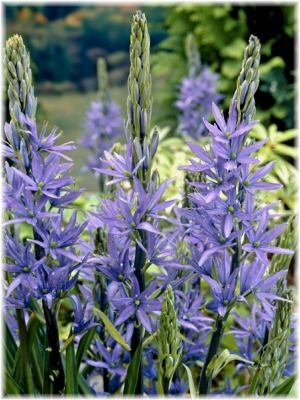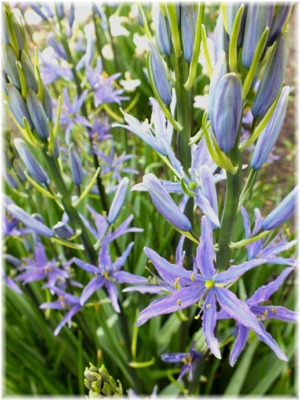 One of the most widely used varieties of Camassia in Dutch show gardens, deer-resistant Camassia leichtlinii caerulea has six-petaled, deep lavender-blue flowers with delicate pale green filaments, ivory anthers and little yellow-green centers. A selection out of Camassia leichtlinii, it has deep green, upright, sword-like foliage around the base of its flower-encrusted racemes. It is stunning as a cohesive backdrop for a lengthy perennial bed, in substantive clusters among yet-to-flower summer perennials or in seemingly uncultivated woodland drifts in full to filtered sunlight.
One of the most widely used varieties of Camassia in Dutch show gardens, deer-resistant Camassia leichtlinii caerulea has six-petaled, deep lavender-blue flowers with delicate pale green filaments, ivory anthers and little yellow-green centers. A selection out of Camassia leichtlinii, it has deep green, upright, sword-like foliage around the base of its flower-encrusted racemes. It is stunning as a cohesive backdrop for a lengthy perennial bed, in substantive clusters among yet-to-flower summer perennials or in seemingly uncultivated woodland drifts in full to filtered sunlight.
 3′ Foot Racemes of Star-Shaped Sapphire Flowers
3′ Foot Racemes of Star-Shaped Sapphire Flowers
Carefree and long-blooming in May/June in horticultural zone 5, its dainty star-shaped flowers start opening from the bottom of the flowering racemes, eventually blooming to the top of its blue-to-green spikes. Its sapphire-indigo coloration varies in intensity from morning's early sunlight to late afternoon's golden brilliance. Growing from 24″ to 30″ tall, Camassia leichtlinii caerulea grows into increasingly more substantive plants as it matures over the years. Encountering a thick, mature stand of Camassia leichtlinii caerulea gives one a refreshing feeling, as if brushed by ion-drenched breezes in a late spring electrical storm when the world is brilliant neon-green under a blue-gray sky.
Northwest Pacific U.S. Native As a genus, Camassia is native to America's Pacific northwest where it was known as the great camas or as quamash to American Indians, who boiled or roasted its roots for nourishment (but please don't try to eat it: few taste-testers have preferred its viscous, pasty texture once boiled and mashed.) As early as the mid-1800s, Camassia flourished abundantly as wild flowers in moisture-laden soil near streams and in areas that received beneficial summer rains like damp mountain meadows. Generally, it has been referred to as the wild hyacinth although it bears no fragrance. Happily, deer do not usually eat them, nor do underground rodents munch on them.
As a genus, Camassia is native to America's Pacific northwest where it was known as the great camas or as quamash to American Indians, who boiled or roasted its roots for nourishment (but please don't try to eat it: few taste-testers have preferred its viscous, pasty texture once boiled and mashed.) As early as the mid-1800s, Camassia flourished abundantly as wild flowers in moisture-laden soil near streams and in areas that received beneficial summer rains like damp mountain meadows. Generally, it has been referred to as the wild hyacinth although it bears no fragrance. Happily, deer do not usually eat them, nor do underground rodents munch on them.
 Plant Camassia leichtlinii caerulea bulbs in the fall after the soil has cooled down to around 55 degrees F (after two weeks of sweater weather when night time temps hover in the 40s), in somewhat moist, neutral pH soil in moderate to full sunlight: 5″ deep and 5″ apart. If you are planting them near a stream or pond, make sure to plant them above the high water mark: no bulb likes to sit in standing water, even Camassia. (Other moisture-tolerant flower bulbs include Allium triquetrum, Corydalis solida, Eranthis hyemalis, Erythronium pagoda, Fritillaria meleagris and meleagris alba, Galanthus and Leucojum.) Top dress the garden three times a year with a 4-10-6 granular organic flower bulb fertilizer: at fall planting time, spring sprouting time and when the flower starts to die back. Camassia leichtlinii caerulea is a wonderful companion for many of the tall globe-shaped Allium, Brodiaea (another Pacific northwest native), Dutch Iris, Eremurus, Hardy Geraniums and romantic trellises of Wisteria. We love it with woodland ferns, and Hostas in lush blue-green vignettes.
Plant Camassia leichtlinii caerulea bulbs in the fall after the soil has cooled down to around 55 degrees F (after two weeks of sweater weather when night time temps hover in the 40s), in somewhat moist, neutral pH soil in moderate to full sunlight: 5″ deep and 5″ apart. If you are planting them near a stream or pond, make sure to plant them above the high water mark: no bulb likes to sit in standing water, even Camassia. (Other moisture-tolerant flower bulbs include Allium triquetrum, Corydalis solida, Eranthis hyemalis, Erythronium pagoda, Fritillaria meleagris and meleagris alba, Galanthus and Leucojum.) Top dress the garden three times a year with a 4-10-6 granular organic flower bulb fertilizer: at fall planting time, spring sprouting time and when the flower starts to die back. Camassia leichtlinii caerulea is a wonderful companion for many of the tall globe-shaped Allium, Brodiaea (another Pacific northwest native), Dutch Iris, Eremurus, Hardy Geraniums and romantic trellises of Wisteria. We love it with woodland ferns, and Hostas in lush blue-green vignettes.




